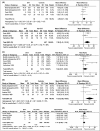The impact of deep vein thrombosis in critically ill patients: a meta-analysis of major clinical outcomes
- PMID: 26513770
- PMCID: PMC4624530
- DOI: 10.2450/2015.0277-14
The impact of deep vein thrombosis in critically ill patients: a meta-analysis of major clinical outcomes
Abstract
Background: Critically ill patients appear to be at high risk of developing deep vein thrombosis (DVT) and pulmonary embolism during their stay in the intensive care unit (ICU). However, little is known about the clinical course of venous thromboembolism in the ICU setting. We therefore evaluated, through a systematic review of the literature, the available data on the impact of a diagnosis of DVT on hospital and ICU stay, duration of mechanical ventilation and mortality in critically ill patients. We also tried to determine whether currently adopted prophylactic measures need to be revised and improved in the ICU setting.
Materials and methods: MEDLINE and EMBASE databases were searched up to week 4 of June 2012. Two reviewers selected studies and extracted data. Pooled results are reported as relative risks and weighted mean differences and are presented with 95% confidence intervals (CI).
Results: Seven studies for a total of 1,783 patients were included. A diagnosis of DVT was frequent in these patients with a mean rate of 12.7% (95% CI: 8.7-17.5%). DVT patients had longer ICU and hospital stays compared to those without DVT (7.28 days; 95% CI: 1.4-13.15; and 11.2 days; 95% CI: 3.82-18.63 days, respectively). The duration of mechanical ventilation was significantly increased in DVT patients (weighted mean difference: 4.85 days; 95% CI: 2.07-7.63). DVT patients had a marginally significant increase in the risk of hospital mortality (relative risk 1.31; 95% CI: 0.99-1.74; p=0.06), and a not statistically significant increase in the risk of ICU mortality (RR 1.64; 95% CI: 0.91-2.93; p=0.10).
Conclusions: A diagnosis of DVT upon ICU admission appears to affect clinically important outcomes including duration of ICU and hospital stay and hospital mortality. Larger, prospective studies are warranted.
Figures


References
-
- Cook D, Attia J, Weaver B, et al. Venous thromboembolic disease: an observational study in medical-surgical intensive care unit patients. J Crit Care. 2000;15:127–32. - PubMed
-
- Gando S, Kameue T, Nanzaki S, et al. Participation of tissue factor and thrombin in posttraumatic systemic inflammatory syndrome. Crit Care Med. 1997;25:1820–6. - PubMed
-
- Crowther MA, Cook DJ, Griffith LE, et al. Neither baseline tests of molecular hypercoagulability nor D-dimer levels predict deep venous thrombosis in critically ill medical-surgical patients. Intensive Care Med. 2005;31:48–55. - PubMed
-
- Crowther MA, McDonald E, Johnston M, et al. Vitamin K deficiency and D-dimer levels in the intensive care unit: a prospective cohort study. Blood Coagul Fibrinolysis. 2002;13:49–52. - PubMed
-
- Ginsberg JS, Kearon C, Douketis J, et al. The use of D-dimer testing and impedance plethysmographic examination in patients with clinical indications of deep vein thrombosis. Arch Intern Med. 1997;157:1077–81. - PubMed
Publication types
MeSH terms
LinkOut - more resources
Full Text Sources
Medical
